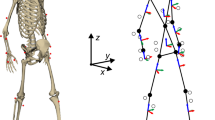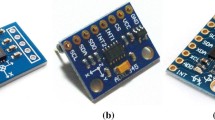Abstract
This paper presents a new method for estimating the isometric contraction force and the characterization of muscle’s intrinsic property. The method, called the energy kernel method, starts with converting the electromyography (EMG) signal into planar phase portraits, on which the elliptic distribution of the state points is named as the energy kernel, while that formed by the noise signal is called the noise kernel. Based on such stochastic features of the phase portraits, we approximate the EMG signal within a rectangular window as a harmonic oscillator (EMG oscillator). The study establishes the relationship between the energy of control signal (EMG) and that of output signal (force/power), and a characteristic energy is proposed to estimate the muscle force. On the other hand, the natural frequencies of the noise and the EMG signal can be attained with the energy kernel and noise kernel. In this way, the direct signal–noise recognition and separation can be accomplished. The results show that the representativeness of the characteristic energy toward the force is satisfactory, and the method is very robust since it combines the advantages of both RMS and MPF. Moreover, the natural frequency of the EMG oscillator is not governed by the MU firing rate of a specific muscle, indicating that this frequency correlates with the intrinsic property of muscle. The physical meanings of the model provide new insights into the understanding of EMG.










Similar content being viewed by others
References
Staudenmann D, Roeleveld K, Stegeman DF et al (2010) Methodological aspects of SEMG recordings for force estimation: a tutorial and review. J Electromyopr Kinesiol 20:375–387
Bigland-Ritchie B, Donovan EF, Roussos CS (1981) Conduction velocity and EMG power spectrum changes in fatigue of sustained maximal efforts. J Appl Physiol 51:1300–1305
Mannion AF, Connolly B, Wood K et al (1997) The use of surface EMG power spectral analysis in the evaluation of back muscle function. J Rehabil Res Dev 34:427–439
Komi PV, Tesch P (1979) EMG frequency spectrum, muscle structure, and fatigue during dynamic contractions in man. Eur J Appl Physiol Occup Physiol 42:41–50
Güler NF, Koçer S (2005) Classification of EMG signals using PCA and FFT. J Med Syst 29:241–250
Talebinejad M, Chan ADC, Miri A et al (2009) Fractal analysis of surface electromyography signals: a novel power spectrum-based method. J Electromyopr Kinesiol 19:840–850
Christie A, Inglis G, Kamen G (2009) Relationships between surface EMG variables and motor unit firing rates. Eur J Appl Physiol 107:177–185
Qi L, Wakeling JM, Green A et al (2011) Spectral properties of electromyographic and mechanomyographic signals during isometric ramp and step contractions in biceps brachii. J Electromyopr Kinesiol 21:128–135
Gabor D (1946) Theory of communication. J Inst Electr Eng 93:429–457
Claasen T, Mecklenbrauker W (1980) The Wigner distribution: a tool for time-frequency analysis. Part I: continuous-time signals. Phylips J Res 35:217–250
Wang G, Wang ZZ, Chen WT et al (2006) Classification of surface EMG signals using optimal wavelet packet method based on Davies–Bouldin criterion. Med Biol Eng Comput 44:865–872
Michele GD, Sello S, Garboncini MC et al (2003) Cross-correlation time-frequency analysis for multiple EMG signals in Parkinson’s disease: a wavelet approach. Med Eng Phys 25:361–369
Zhang QJ, Luo ZZ, Ye M (2005) Based on power spectrum and RBF neural network to classify surface electromyography (in Chinese). Mech Electr Eng Mag 22:35–38
Kukolj D, Levi E (2003) Identification of complex systems based on neural and Takagi–Sugeno fuzzy model. IEEE Trans Syst Man Cybern B 34:272–282
Vineet G, Srikanth S, Narender PR (1997) Fractal analysis of surface EMG signals from the biceps. Int J Med Inform 45:185–192
Holobar A, Zazula D (2007) Multi-channel blind source separation using convolution kernel compensation. IEEE Trans Signal Proc 8:4487–4496
Azzerboni B, Finocchio G, Ipsale M et al (2002) A new approach to detection of muscle activation by independent component analysis and wavelet transform. Comput Sci 2486:109–116
Nair SS, French RM, Laroche D et al (2010) The application of machine learning algorithms to the analysis of electromyographic patterns from arthritic patients. IEEE Trans Neural Syst Rehabil Eng 18:174–184
Levi JH, Erik JS, Kevin BE et al (2010) Multiple binary classifications via linear discriminant analysis for improved controllability of a powered prosthesis. IEEE Trans Neural Syst Rehabil Eng 18:49–57
Yin YH, Guo Z, Chen X et al (2012) Studies on biomechanics of skeletal muscle based on the working mechanism of myosin motors: an overview. Chin Sci Bull 57:2794–2805
Guo Z, Fan YJ, Zhang JJ, et al. (2012) A new 4 M model-based human-machine interface for lower extremity exoskeleton robot. In: The 5th international conference on intelligent robotics and applications, Montreal. Springer, Berlin, pp 123–130
Gabriel DA, Christie A, Inglis JG et al (2011) Experimental and modeling investigation of surface EMG spike analysis. Med Eng Phys 33:427–437
Merletti R, Conte LL, Avignone E et al (1999) Modeling of surface myoelectric signals. Part I: model implementation. IEEE Trans Biomed Eng 46:810–820
Day SJ, Hulliger M (2001) Experimental simulation of cat electromyogram: evidence for algebraic summation of motor-unit action-potential trains. J Neurophysiol 86:2144–2158
Yang JH, Yang HN, Zhou P et al (1999) Study on automatic decomposition of EMG signals with overlapping MUAP waveform (in Chinese). Chin J Biomed Eng 18:82–88
McComas AJ, Mrozek K, Gardner-Medwin D et al (1968) Electrical properties of muscle fibre membranes in man. J Neurol Neurosurg Phychiatry 31:434–440
Yin YH, Chen X (2012) Bioelectrochemical control mechanism with variable-frequency regulation for skeletal muscle contraction—Biomechanics of skeletal muscle based on the working mechanism of myosin motors (II). Sci China Technol Sci 55:2115–2125
Kesar T, Chou LW, Binder-Macleod SA (2008) Effects of stimulation frequency versus pulse duration modulation on muscle fatigue. J Electromyopr Kinesiol 18:662–671
Yin YH, Fan YJ, Xu LD (2012) EMG & EPP-integrated human-machine interface between the paralyzed and rehabilitation exoskeleton. IEEE Trans Inf Technol Biomed 16:542–549
Yin YH, Fan YJ, Guo Z (2011) sEMG-based neuro-fuzzy controller for a parallel ankle exoskeleton with proprioception. Int J Robot Autom 26:450–460
Fan YJ, Yin YH (2012) Differentiated time-frequency characteristics based real-time human-machine interface for lower extremity rehabilitation exoskeleton robot. In: The 5th international conference on intelligent robotics and applications, Montreal. Springer, Berlin, pp 31–40
Zhou S, Lawson DL, Morrison WE (1995) Electromechanical delay in isometric muscle contractions evoked by voluntary, reflex and electrical stimulation. Eur J Appl Physiol 70:138–145
Rasmussen J, Damsgaard M, Voigt M (2001) Muscle recruitment by the min/max criterion-a comparative numerical study. J Biomech 34:409–415
Zhou QX, Chen YH, Ma C et al (2011) Evaluation of upper limb muscle fatigue based on surface electromyography. Sci China Life Sci 54:939–944
Lowery MM, Stoykov NS, Dewald JPA et al (2004) Volume conduction in an anatomically based surface EMG model. IEEE Trans Biomed Eng 51:2138–2147
Ren Q, Zhao YP, Yue JC et al (2006) Biological application of multi-component nanowires in hybrid devices powered by F1-ATPase motors. Biomed Microdevices 8:201–208
Guo Z, Yin YH (2012) A dynamic model of skeletal muscle based on collective behavior of myosin motors—Biomechanics of skeletal muscle based on working mechanism of myosin motors (I). Sci China Technol Sci 55:1589–1595
Chen X, Yin YH (2012) A dynamical system-Markov model for active postsynaptic responses of muscle spindle afferent nerve. Chin Sci Bull 58:603–612
Acknowledgments
This work was supported by the National Basic Research Program of China (2011CB013203), the National Natural Science Foundation of China (61375098, 61075101), and the Science and Technology Intercrossing Research Foundation of Shanghai Jiao Tong University (LG2011ZD106).
Author information
Authors and Affiliations
Corresponding author
About this article
Cite this article
Chen, X., Yin, Y. & Fan, Y. EMG oscillator model-based energy kernel method for characterizing muscle intrinsic property under isometric contraction. Chin. Sci. Bull. 59, 1556–1567 (2014). https://doi.org/10.1007/s11434-014-0147-3
Received:
Accepted:
Published:
Issue Date:
DOI: https://doi.org/10.1007/s11434-014-0147-3




